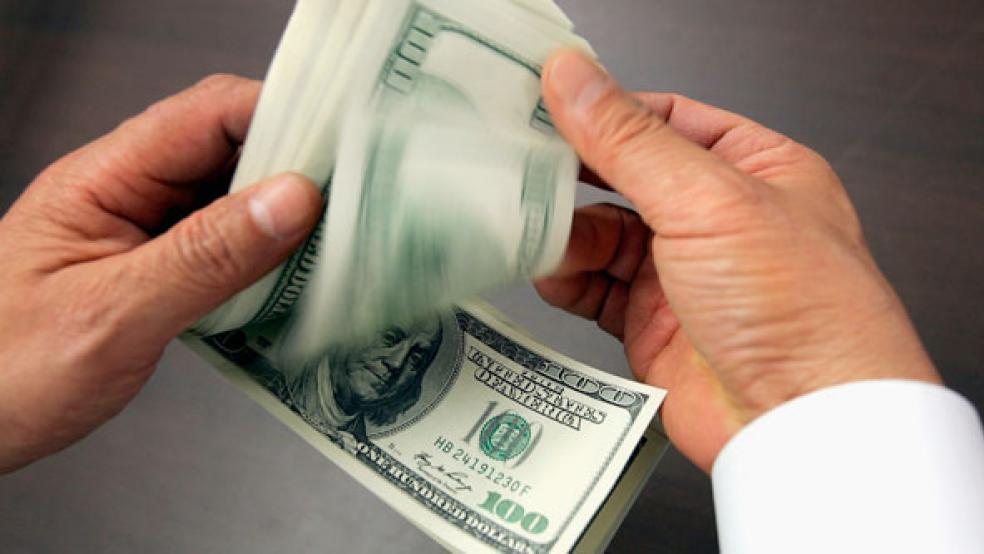This is an essay about bonds and credit risk, and — fair warning — might even mention credit default swaps. But before your eyes go completely glassy, let’s put Treasury bonds in human terms. They are after all just loans, no different fundamentally from a personal loan from a community bank. So imagine that you are the lending officer at the Bank of You, and Mr. and Mrs. Tim Geithner are applying for a loan and answering questions any prudent lender would ask:
Why do you need this loan? We provide our large family a vast array of services, from anti-terrorism to highway repair to unemployment relief, among many, many others. This year we plan to spend $3.8 trillion, of which we need to borrow $1.6 trillion.
How will you repay the bank? Every year we collect a share of the income our kids produce. We expect that income to be $14.7 trillion this year. Some of that will go to you.
Can I be sure? If we were ever to come up short on what we owed, we could just take more of our kids’ money. And remember: We’ve always paid in full in the past.
Yes, but have you ever borrowed this much before? Well, no. This loan comes to about 10.9 percent of our total family income, more than at any point in the past 60 years. Oh, and we expect to borrow nearly as much each year for the next 10.
Hasn’t the recession hurt your ability to pay? Well, yes, that too. It lowered our kids’ income, so we’ll need either to take a larger share of their earnings or collect less income.
Any unexpected expenses? Our parents are getting older and will increasingly rely on us for pension and medical costs. It’s not like we can’t see it coming, but we have no realistic plan to pay for it.
Why don’t you just spend less? At the moment, our family doesn’t have the will power. Chalk it up to sibling rivalry: To be popular with the friends, they say they need to spend money. What’s a parent to do?
What’s your plan B? We keep a guy in the basement, Ben Bernanke, who prints very convincing $100 bills.
What interest rate are you willing to pay? Glad you asked. How does 0.88 percent on a two-year loan sound?
That, in metaphorical terms, is the value proposition of Treasury bonds today. If you think 0.88 percent (or even 3.4 percent, the going rate on 10-year Treasurys) sounds inadequate, you’re in pretty good company. “Return-free risk,” sniffs Grant’s Interest Rate Observer’s Jim Grant. Bill Gross, head of bond investment giant PIMCO, says, “Given current yields, I prefer to invest in Canada.” Warren Buffett himself delivered the most damning indictment, saying in his annual shareholder letter that Treasurys are in a bubble that would rival the Internet stock and housing debacles.
“Bubble” isn’t a word usually applied to an investment backed by the full faith and credit of the U.S. government. In the past, there was not the slightest question that the U.S. Treasury — secured by the most productive economy in the world and enforced by IRS tax collectors — would be able to meet its payments in full. When traditional economics texts talk about the “risk-free” rate, they mean the yield on Treasurys.
To be sure, you could have lost money in Treasury bonds in the past. In the early 1980s and 1994, for example, the prospect of inflation threatened to erode the real value of the bonds’ interest payments and the price of the bonds plunged.
But this is different. For the first time, the source of uncertainty isn’t some external economic event. It’s the Treasury’s ability to make good on its promises. “The actual probability of a U.S. default is still very small, but it has risen significantly from the crisis,” says Joseph Mason, a banking professor at Louisiana State University. One way to measure the likelihood is by looking at the price of credit default swaps on U.S. debt, essentially insurance against a U.S. default. CDS spreads have more than doubled in the past few months; it recently cost over $4,000 to insure $1 million of Treasurys. (The U.S. is still nowhere near Greece, however, where the comparable premium is eight times as high.) Early in February, credit agency Moody’s warned that it would downgrade the Treasury’s gold-plated AAA rating if the country didn’t stop piling up debt.
There’s still little chance that the U.S. might simply walk away from its debt, like a foreclosed homeowner (or like Russia in 1998). But that’s not the only way to renege. “The more relevant threat,” says Mason, “is inflation.” The Federal Reserve could simply create enough money out of thin air to buy up newly minted Treasury bonds (see the Geithner family’s Plan B above). If that happened, inflation would explode. Treasury bond holders would get back the dollars they were promised, but each dollar would be worth just a fraction of its original value. It would be a default in all but name.
So far, of course, these dire outcomes remain speculation. Inflation is mild to nonexistent. The world’s investors continue to buy as many bonds as the Treasury can issue. When panicked by credit crises elsewhere in the world — as in Dubai last year or Greece last month — investors still flock to Treasurys as a safe haven.
But this much we do know: President Obama has submitted a budget that calls for the country to borrow more in the next three years of its life than it did in the first 200. There is no evident will to rein in spending and no plan at all to deal with the inevitable explosion of Social Security and Medicare costs when the baby boom generation retires. To lend to a family or a government under those circumstances, you should expect to be paid a lot more than 0.88 percent.
Reporter: Temma Ehrenfeld
Eric Schurenberg is Editor-in-Chief of BNET, the CBS Business Network.






